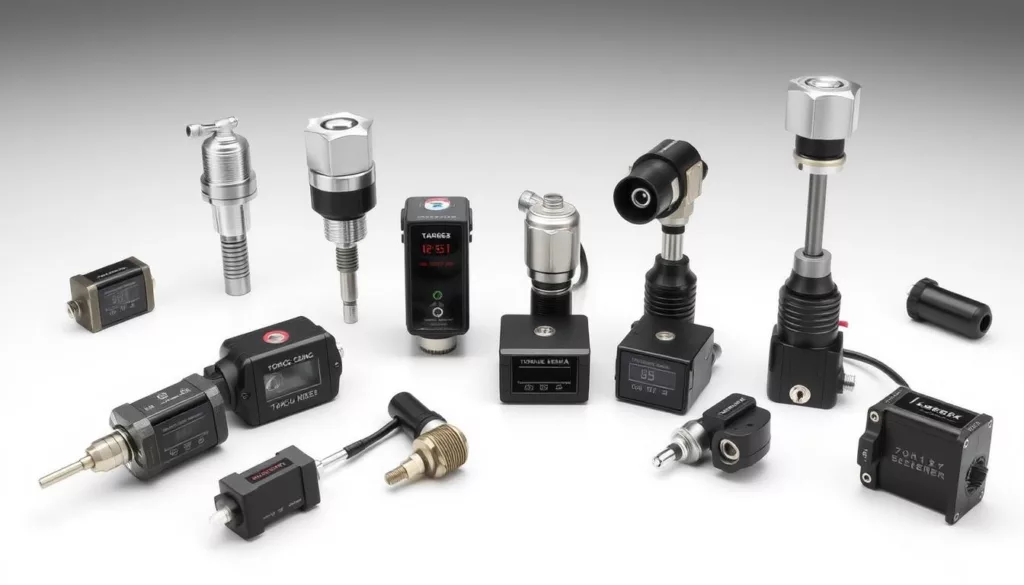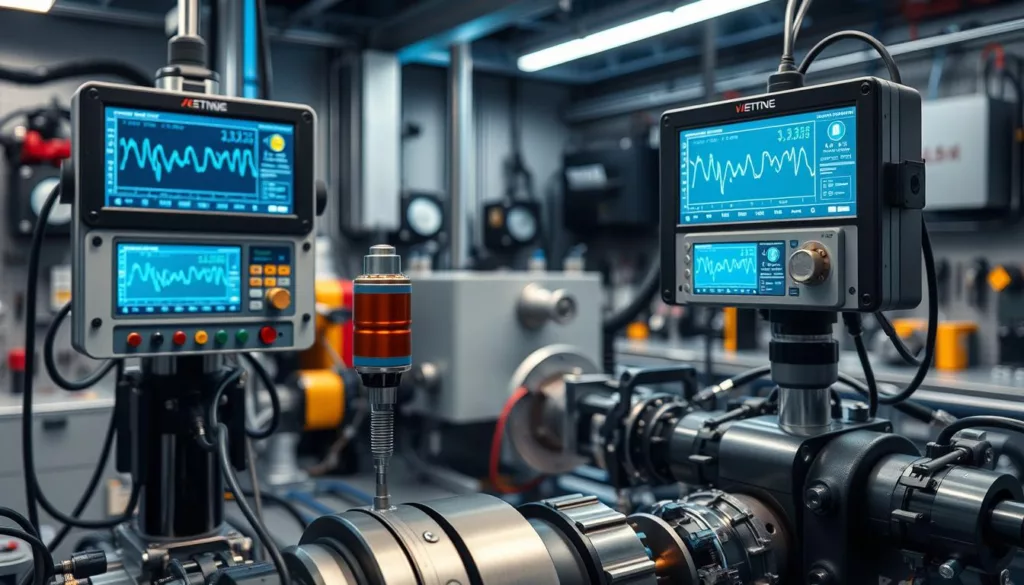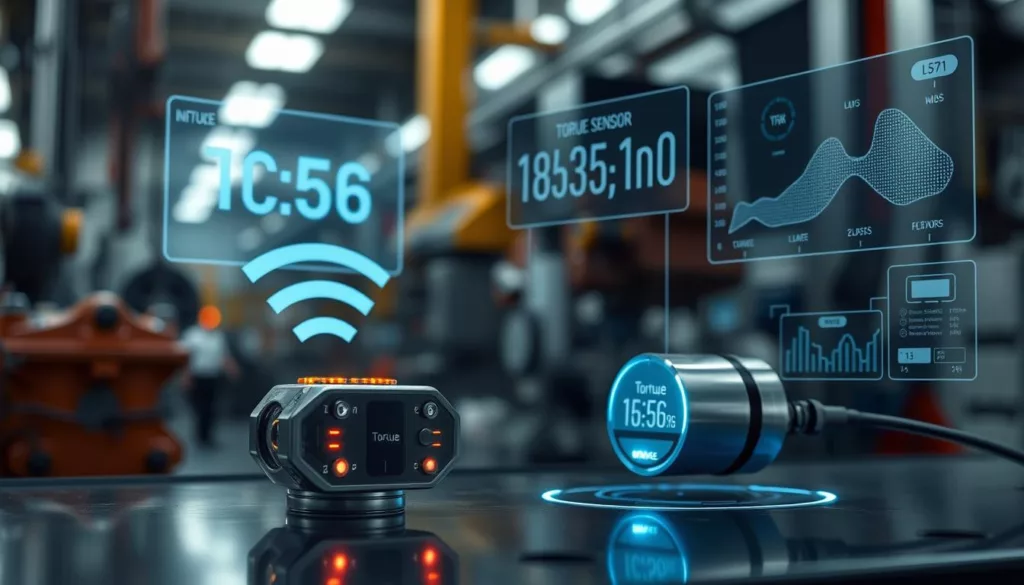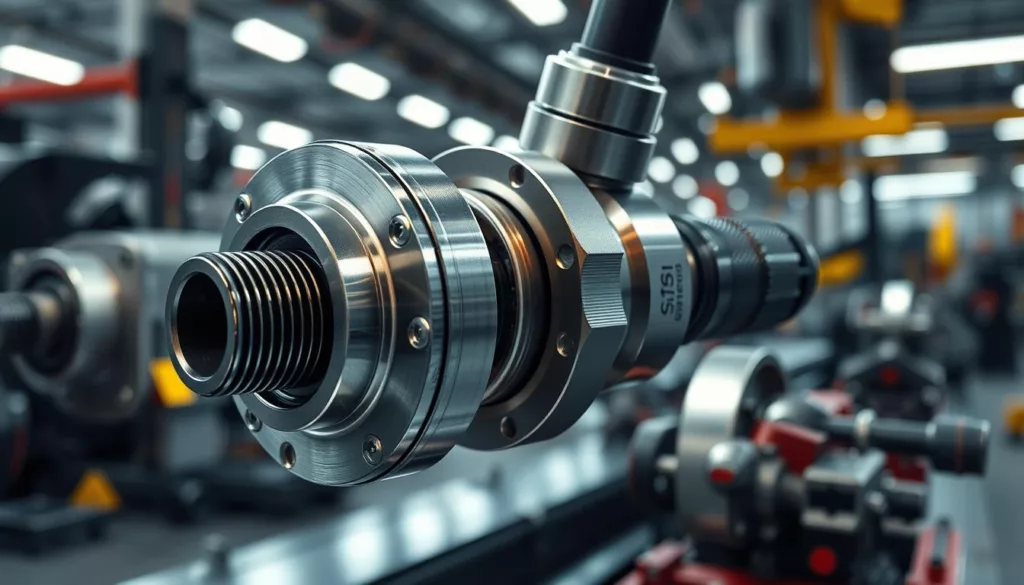In today’s fast world, precise torque measurement is key. Dynamic torque sensors lead in real-time monitoring, with unmatched accuracy and speed. They’re used in car making, robotics, and more, changing how we measure and control force.
This guide looks at the best torque sensors for real-time measurement. We cover new tech, specs, and how to use them. It’s for engineers, buyers, and leaders who need to know about torque sensing.
Key Takeaways
- Explore the latest advancements in dynamic torque sensor technology, including high-precision transducers and IoT-enabled solutions.
- Understand the basic principles of torque measurement and the historical development of sensor innovations.
- Discover the best torque sensors for real-time monitoring in industrial, automotive, and manufacturing applications.
- Learn about the key technical specifications, cost-benefit analysis, and implementation considerations for selecting the right torque sensor.
- Gain insights into best practices for installation, calibration, and maintenance of high-precision torque measurement systems.
Understanding Torque Sensor Technology and Its Evolution
Torque measurement is key in engineering and manufacturing. It has evolved from mechanical systems to electronic and optical sensors. We’ll look at how torque sensors have changed over time.
Basic Principles of Torque Measurement
Torque measurement is based on force and distance. When you apply force at a certain distance, you can measure the torque. This idea is the base for many torque measurement methods, like non-contact torque measurement, rotary torque sensors, and static torque monitoring.
Historical Development of Torque Sensing
The history of torque sensing started in the early 20th century. Back then, mechanical systems were used to measure torque. These systems used springs or levers to measure force. Later, electronic sensors came along, making measurements more accurate and reliable.
Modern Advancements in Sensor Technology
Today, torque sensing is changing fast. New technologies like optical and wireless sensors have made non-contact torque measurement possible. These advancements in rotary torque sensors and static torque monitoring have changed how we measure and improve mechanical systems.
“The ability to accurately measure and monitor torque is essential for ensuring the safe and efficient operation of machinery in a wide range of applications.”
Best Torque Sensors for Real-Time Measurement
In the fast-paced world of industrial manufacturing and automation, precise torque measurement is key. Force and dynamic torque analysis sensors are essential for efficiency, safety, and quality in many industrial torque applications. We’ve put together a list of top torque sensors for real-time measurement across different industries.
- Strain Gauge Torque Sensors: These sensors use strain gauges to measure twisting force on a shaft. They give accurate and reliable torque data. They’re great for robotics, automotive testing, and monitoring industrial machinery.
- Optical Torque Sensors: These sensors use fiber optic technology for high precision and durability. They’re perfect for high-speed machinery, aerospace, and medical equipment.
- Magnetoelastic Torque Sensors: These sensors use magnetoelastic materials for accurate torque measurements in harsh environments. They’re ideal for power tools, automotive drivelines, and industrial automation.
| Sensor Type | Accuracy | Reliability | Suitability |
|---|---|---|---|
| Strain Gauge | High | Excellent | Robotics, Automotive, Industrial Machinery |
| Optical | Exceptional | Superior | High-Speed Rotating Machinery, Aerospace, Medical |
| Magnetoelastic | Precise | Robust | Power Tools, Automotive Drivelines, Industrial Automation |
By looking at the accuracy, reliability, and suitability of these sensors, professionals can choose the right ones. This ensures the best fit for their dynamic torque analysis and industrial torque applications.
“Accurate and reliable torque measurement is the cornerstone of efficient industrial operations, ensuring quality, safety, and optimal performance across a wide range of applications.”
High-Precision Static Torque Monitoring Solutions
In the world of industry and labs, getting accurate static torque is key. XJCSENSOR has a variety of high-precision solutions for this. We have everything from tough industrial sensors to precise lab tools, all for reliable torque data.
Industrial Grade Static Sensors
Our industrial-grade sensors are built to last in tough production settings. They use advanced strain gauge tech for accurate, live measurements. These sensors are strong, can handle a lot of stress, and are perfect for critical torque checks in factories.
Laboratory Precision Instruments
For top accuracy, our lab-grade transducers are the best. They meet strict lab standards with advanced tech and calibration. These are ideal for research and testing where exact torque data is needed.
Calibration and Accuracy Standards
- Comprehensive in-house calibration facilities
- Adherence to international standards for high-precision torque transducers
- Traceability to national and international metrology institutes
- Calibration certificates provided with every sensor
- Ongoing maintenance and recalibration services
At XJCSENSOR, we know how vital accurate measurements are. That’s why we focus on top-notch calibration and quality. We ensure our customers can rely on the data they get from us.
Non-Contact Rotary Torque Measurement Systems
In the world of industrial monitoring, non-contact torque measurement systems are leading the way. They accurately track rotational forces in real-time. These systems offer big advantages over old methods, making them key for industries needing constant, reliable torque data.
At the heart of this change are rotary torque sensors. They use different methods to measure torque without touching. For example, magnetoelastic sensors use magnetic properties to detect strain. Optical sensors measure forces by watching light beam interference. Capacitive sensors, on the other hand, use electrical changes to measure torque.
Non-contact torque systems have many benefits. They don’t need physical connections, which means less wear and tear. This makes the system more reliable and lasts longer, cutting down on downtime and costs.
| Technology | Advantages | Typical Applications |
|---|---|---|
| Magnetoelastic Sensors | High accuracy, wide measurement range, and robust design | Rotating machinery, power transmission systems, and automotive test stands |
| Optical Sensors | Immunity to electromagnetic interference, high resolution, and suitability for harsh environments | Wind turbines, aerospace applications, and medical equipment |
| Capacitive Sensors | Compact size, low power consumption, and cost-effective implementation | Robotics, industrial automation, and consumer electronics |
Using these non-contact torque measurement technologies, industries can get deep insights into their machines. This helps them plan better maintenance, improve efficiency, and avoid sudden failures.
“Non-contact torque sensors have revolutionized the way we monitor and control rotating equipment, unlocking new levels of reliability and productivity in industrial settings.”
Smart IoT-Enabled Torque Monitoring Devices
In the era of Industry 4.0, the need for advanced torque control systems is high. XJCSENSOR has answered this need with a range of IoT-enabled torque monitoring devices. These devices are changing how we do predictive maintenance and optimize processes.
Cloud Integration Capabilities
These smart sensors work with cloud platforms for real-time data. This lets users monitor from anywhere, making it easier to keep operations running smoothly.
Real-Time Data Analytics Features
The advanced analytics of these devices offer deep insights. They help spot issues early, improving productivity and reducing downtime.
Remote Monitoring Solutions
Manual inspections are a thing of the past. These solutions allow for remote monitoring. Users can track performance, get alerts, and adjust settings from anywhere. This is a big step forward for industries needing precise IoT-enabled torque monitoring and intelligent torque control systems.
“XJCSENSOR’s IoT-enabled torque monitoring devices have transformed the way we approach maintenance and process optimization. The real-time data and remote capabilities have unlocked a new level of efficiency and control in our operations.”
| Feature | Benefit |
|---|---|
| Cloud Integration | Centralized monitoring and remote access to critical data |
| Real-Time Analytics | Predictive maintenance, process optimization, and enhanced productivity |
| Remote Monitoring | Comprehensive visibility and control, reducing the need for on-site inspections |
Automotive and Manufacturing Applications
Torque sensors are key in the automotive and manufacturing worlds. They help monitor and improve important processes in real-time. In cars, they’re vital for engine and transmission tests, making sure power is delivered well and efficiently.
By measuring torque accurately, engineers can make engines run better, save fuel, and improve how cars drive.
In manufacturing, torque sensing applications help with quality control and making processes better. Sensors on production lines give data on torque changes. This helps spot problems, avoid equipment breakdowns, and keep product quality steady.
This approach helps companies work better, cut down on waste, and make better products for their customers.
| Application | Key Benefits |
|---|---|
| Automotive Torque Sensing |
|
| Industrial Torque Applications |
|
By using automotive torque sensing and industrial torque applications together, companies can reach new heights in performance, efficiency, and quality. This leads to better products and services for their customers.
“Accurate, real-time torque measurement is the foundation for optimizing critical automotive and manufacturing processes.”
Selecting the Right Torque Sensor for Your Needs
Choosing the right torque sensor is key for real-time measurement and dynamic torque analysis. You need to look at technical specs, cost, and how it fits into your system. This ensures the sensor works well for your needs.
Key Technical Specifications
The specs of a torque sensor are very important. They help you decide if it’s right for your application. Here are some key things to check:
- Measurement range: Make sure the sensor can handle the torque your system needs.
- Accuracy and resolution: Pick a sensor that matches your precision needs.
- Frequency response: Choose a sensor that fits your dynamic torque analysis needs.
- Mounting options: Make sure the sensor can be mounted securely and reliably.
Cost-Benefit Analysis
Doing a cost-benefit analysis is vital when picking a torque sensor. Consider these points:
- Initial purchase price: Check the sensor’s cost against your budget and expected return.
- Operational expenses: Think about the ongoing costs like maintenance and power.
- Potential cost savings: See how the sensor’s features can save you money by improving your processes.
Implementation Considerations
Implementing a torque sensor right involves practical steps. Here are some to keep in mind:
- Integration with existing systems: Make sure the sensor works well with your current setup.
- Environmental factors: Check how the sensor handles conditions like temperature and vibrations.
- User-friendliness: Choose a sensor that’s easy to install, calibrate, and understand.
By focusing on these areas, you can pick the best torque sensors for your needs. This ensures top performance and a good return on your investment.
Installation and Maintenance Best Practices
Proper installation and regular maintenance are key for torque sensors to work well over time. At XJCSENSOR, we offer expert advice to help professionals get the most out of these important tools.
Precise Sensor Alignment
Getting accurate torque readings starts with aligning the sensor right. Our team advises to follow detailed installation guides and use special tools for alignment. It’s also important to mount and secure the sensor well to avoid any issues later.
Calibration and Troubleshooting
Keeping the torque sensor precise means regular calibration. We recommend setting up a calibration schedule based on how often it’s used and the environment. Our experts can help with calibration and solve any problems, like signal issues or wrong readings.
| Maintenance Task | Frequency |
|---|---|
| Sensor Inspection | Monthly |
| Calibration | Quarterly |
| Cleaning and Lubrication | Bi-annually |
“Proper installation and maintenance of torque sensors are essential for ensuring accurate, reliable data collection in industrial applications.”
Following these best practices helps our customers get the most out of their torque sensors. This leads to more efficient work and better decisions. Our team is here to offer personalized help and support at every step.
Conclusion
The world of torque sensing technology has grown a lot. It now offers many high-precision solutions for real-time measurement. This is great for both industrial and automotive professionals.
There are now many options, from static torque monitoring systems to IoT-enabled devices. These advancements have changed how we handle important tasks in different industries.
If you need best torque sensors for real-time measurement or high-precision torque transducers, you have many choices. The market offers specialized products for your needs. Knowing the technical specs, costs, and how to use them helps you pick the right one.
This choice improves your work efficiency and helps you make better decisions with data.
The future of torque sensing technology looks bright. We can expect more advanced analytics, cloud connectivity, and predictive maintenance. These new features will change how industries optimize processes, control quality, and prevent maintenance issues.
These changes will lead to better productivity and cost savings. By keeping up with the latest tech, your organization can lead the way. This will help you reach your full operational capacity.






